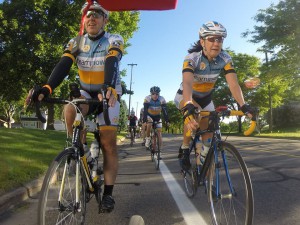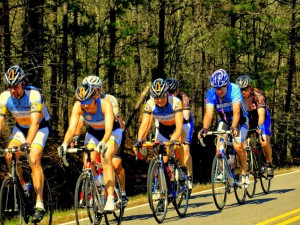By JoAnn Cranson, Team OAM Now Cyclist
Tackling a century ride can be daunting to a cyclist. While base miles under your belt are key, if you know how to draft, the 100 miles go by a lot more easily.
I signed up for the Grand Rapids “100 Grand Bicycle Tour” on June 6th. This tour had options for 17, 35, 65 and 105 miles. I wanted to ride with my Team OAM Now teammates and noticed I was going to be the only woman to ride the 105 miles with them. Even though I don’t have the same power or speed as the men, I knew it was “all about the draft”. I believed I could stay with them if I used the draft and saved my energy for when I needed it.
If you don’t know about drafting, it’s something you must learn to do. Drafting is not about being able to go faster, it’s about making your ride easier and less tiring. It can reduce energy expenditure during long rides by nearly 30% less energy. When you’re covering long distance on a bike, that’s a lot!
The key to drafting is riding safely and effectively in a paceline. A good paceline is smooth and built on trust. It requires that no rider do anything suddenly. Each rider has to be confident that the others in the group will communicate well and ride safely. The best way to learn is to work with a few experienced riders and practice before you try to jump in a big paceline.
Pacelines are either single or double. In a single paceline, everyone lines up behind the first rider, who maintains a constant speed. The rotation occurs when the front rider pulls off to the side and drifts to the back of the line. The next rider then sets the pace. Riders stay on the front for anything from a few seconds to several minutes.
Ideally, you want to be 6″-12″ away from the rider in front of you, although you can get a good draft a wheel’s length away. In other words, getting too close is not absolutely essential. It is also important that you do not ride up along the side the rear wheel of the person in the pace line ahead of you; this is called “overlapping wheels” and can cause a fall if the rider ahead of you swerves to avoid an object in the road.
 Finding the correct drafting position behind a rider is directly related to wind direction, which constantly changes with twists and turns in the road. Try to gauge the wind direction the next time you go out to ride by witnessing trees as they sway in the wind. If the wind isn’t affecting trees then the draft behind a rider will most likely be a direct line, or headwind, as you ride.
Finding the correct drafting position behind a rider is directly related to wind direction, which constantly changes with twists and turns in the road. Try to gauge the wind direction the next time you go out to ride by witnessing trees as they sway in the wind. If the wind isn’t affecting trees then the draft behind a rider will most likely be a direct line, or headwind, as you ride.
A few key points to remember when riding in a paceline:
1. Be aware of upcoming obstacles by keeping your head up and be on the lookout for dangerous situations as they develop. Just because another rider is at the front of a paceline doesn’t mean the riders behind shouldn’t be alert. Watch for upcoming obstacles: cars, potholes, rocks, other riders, etc. If you are in the front or toward the front, communicate “hole,” “car up,”“slowing,” or other changes/obstacles to riders at the back.
2. Also, be cautious of cars approaching from behind. Riders in the back should communicate to riders in the front by calling “Car Back” to notify riders farther up in the paceline of the approaching vehicle.
3. Fluctuations in speed quickly sap a group’s energy just like when you’re on your own doing a time trial. Try to maintain a constant speed.
4. Go easy on the brakes and anticipate pace changes. Try to reduce the accordion or “yo-yo” effect as much as possible.
5. Stay relaxed and don’t grip the handlebars too tight. If you’re relaxed, you can look right/left and still hold a straight line. Holding a line is very important within the context of a group as each member is reliant upon the other members to maintain safety.
6. Pull off into the wind as others may be overlapping your wheel to the draft side.
7. Don’t throw your bike back as you get out of the saddle. Stand up into the bike and bring the bike forward.
Learning how to draft effectively can make all the difference in your success on long rides. Again, it’s best to practice this before you go out to conquer a distance that’s new to you, but with a great team and a great paceline, you can really challenge yourself. I was able to finish 105 miles with 15-20 mph winds with a great group of guys and it was all about the draft.











